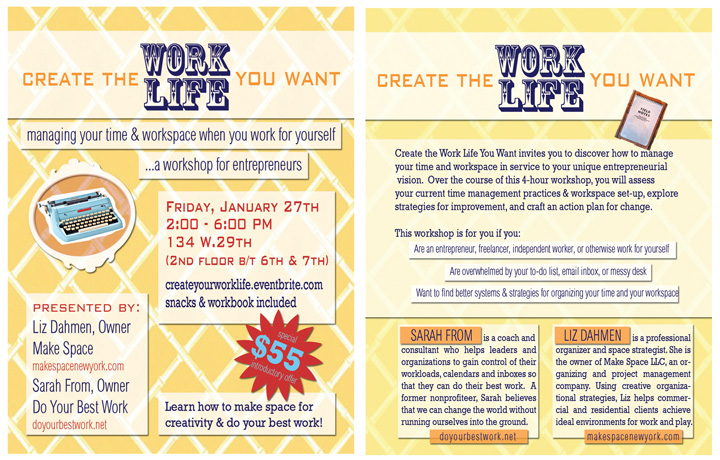[box]This summer I've been collaborating with Liz Dahmen, professional organizer and project manager extraordinaire at Make Space. With Liz's focus on space and my focus on time, we are essentially helping folks with two sides of the same coin. Nearly all of my time management & workflow clients also need some help corralling their physical stuff, so I am sure that Liz's guest post below will resonate. You can read much more from Liz on her blog. Enjoy! - Sarah [/box]
How To Purge With Ease
by Liz Dahmen of Make Space
Problem: It’s time to conduct a major wardrobe/ junk drawer/ garage/ under-the-bed/ you-name-it purge but the thought of sorting through all of that stuff terrifies you.
Solution: Use the rule of threes! Whenever you want to purge, limit yourself to three categories at a time.
Either pull out the drawer or empty it into a box or bucket. Choose your three categories, I like to start with:
1) Trash (it’s amazing how much trash we keep in our drawers! from bits of string to broken rubber bands)
2) Misfiled (items that actually have a home somewhere else and you know where that somewhere else is, like pens- why are there 7 pens in this drawer when I have an entire cup devoted to just pens over there?) WARNING: Resist the temptation to go put them away in the right place, this will lead to major distraction. Just pick up the pen, note that you know where it lives, and put it in the “Misfiled” category.
3) Homeless but Important (you don’t know where it should live, but it’s important- like that necklace with the broken clasp that you have been meaning to take to the jeweler, or the gift certificate to the local movie theater you got for watching your neighbor’s dog)
Now, your first pass is complete! Congratulations! You know what to do with theTrash category. The Misfiled group can now be returned to their actual homes, and all you have left is the Homeless but Important group which is way simpler to tackle than an entire junk drawer. Here we make a second pass and choose three (again, just three!) more categories for our Homeless items, for example:
1) Worth Money (gift certificates, punch cards, coupons)
2) Office Supplies
3) To-Dos (items that are awaiting your attention, like that broken necklace, or something you borrowed that needs to be returned to someone)
As items get whittled down they become easily manageable and you can have fun with your categories, or just let them be inspired by what you see in front of you.
Example 2: Clothes Closet Purge
Go through every single item in that clothes closet and relegate each piece to one of three (no more!) categories. Generally, we always start with the following:
1) Keep (it fits, you love it)
2) Donate/ Recycle (it doesn’t fit, you haven’t worn it in a year)
3) Trash (it’s unwearable, soiled or otherwise unfit for donation)
At the end of the first pass you can expand to three more categories (again, only three at a time!), but now instead of dealing with everything in the closet, you’re just going to sort through the “Keep” pile. For example you may choose to sort it into
1) Off season (if it’s warm, you pull out the cold weather close and store somewhere else)
2) Special occasion (why keep that dress you wear once a year with your work clothes?)
3) Workout wear (finding your gym clothes will be a snap)
By this time, your clothes will be feeling manageable instead of daunting, and you’ll be able to allot the appropriate amount of space in your closet to your different categories.
Read more from Liz Dahmen over at Make Space!



